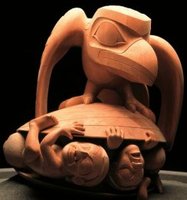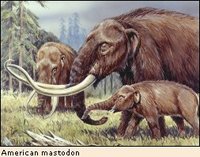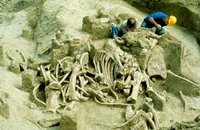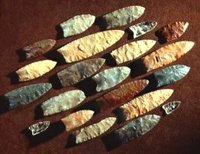Paleoindians and the great pleistocene die-off
| Topics: |
Geology (main)
|
Lead Author: Shepard Krech (other articles)
Content Partners: National Humanities Center (other articles) and TeacherServe (other articles)
Article Topics: Environmental history, Environmental archaeology and Geology
This article has been reviewed and approved by the following Topic Editor: Brian Black (other articles)
EDITOR'S NOTE: This entry was originally published as "Paleoindians and the Great Pleistocene Die-off" in the series "Nature Transformed: The Environment in American History," developed by the National Humanities Center and TeacherServe. Citations should be based on the original essay.

Asked in former days where they came from, American Indians answered in as many voices as there were different cultures. Given the hundreds of sovereign societies in North America in the early sixteenth century, this means hundreds of different voices in former times. Each nation or tribe had its own theory in which the ancestors either came from elsewhere—a world beneath the current one, lands in the east or west, near a salty sea, and so on—or had always been where they were at the time the question was posed.
Today, in contrast, many American Indians agree with the consensus among scientists (regardless of their ethnicity) over the origin of American Indians. Today's consensus, like all scenarios based in science, changes with new data from new sites or with re-interpretations of sites or artifacts long known, in both instances offering fresh insight on the arrival, spread, and behavior of man in the New World. From new data flow new hypotheses, subsequent testing (Hypothesis testing) to falsify or confirm them, and adjustments, if necessary, in theories and the conclusions drawn reasonably from them. For over one hundred years—and after a long period of discussion—almost all scientists have agreed that the ancestors of today's indigenous people came to North America from Asia. And in recent decades they have been in general agreement that these ancient Indians, or Paleoindians (which means "old" Indians), as they are known, arrived some 13,000-14,000 years ago at the end of the period known as the Pleistocene.

The Paleoindians almost surely came to the New World on foot, walking across land exposed when sea levels were much lower. The colder climate from 65,000 to 10,000 years ago locked water up in continental ice sheets and other ice masses, exposing where the Bering Strait is today a land mass known as Beringia. The corridor from Old to New World has often been called a "bridge," but the image is unfortunate: the area left high and dry measured some one thousand miles north to south at its widest and offered opportunity in a cold tundra-steppe environment for generations of animals and humans. In Alaska, new arrivals had two options to move south, one eastward along rivers and through passes to the east flanks of the Rocky Mountains, the other southward along the coast. Which route was most important is debatable, but both led through tundra, boreal forest, deciduous forest, prairie, and desert and other environments like today's but for their location farther south. And everywhere people encountered animals—grazers, browsers, and predators—that would soon be extinct.
The extinctions were remarkable. Animals familiar and unfamiliar, widespread and local, and large and small disappeared. How many species disappeared will never be known, but at least thirty-five mammalian genera (the genus is the next most inclusive category to the species) vanished. Some animals were well-known creatures like lemmings, salamanders, and various birds. Others were very unfamiliar, including many mammals over 100 pounds in weight—so called megafauna.

They included exotic hulking tusked mammoths and mastodons, which towered elephant-like over almost all else on prairies and in boggy woodlands. Several types of slow-moving giant ground sloths as large as mammoths also vanished. So did a kind of giant armadillo, armored 2000-pound six-foot-long glyptodonts resembling nothing known today, single-hump camels, stocky six-foot-long capybaras, 500-pound tapirs, 300-pound giant beavers, four-horned antelopes, horses, bison-sized shrub oxen, stag-moose with fantastic multiple-palmated and -tined antlers, dire wolves whose large heads and powerful jaws made them resemble hyenas, huge fearsome and agile 1500-pound short-faced bears, scimitar-toothed cats which fed on mammoth young, and great saber-toothed cats that could gape, sharklike, opening their jaws to a one-hundred-degree angle before stabbing or ripping open their prey with their enormous canines.
They all vanished, some at indeterminate times but many between 11,000 and 10,000 years ago, or at the moment or shortly after the moment that Paleoindians arrived. That coincidence has spawned debate as fierce as that over the question of human arrival and dispersal in the New World.

More than any other person, Paul Martin, a palynologist and geochronologist, spurred discussion when he proclaimed in 1967 that "man, and man alone, was responsible" for the extinctions. He branded the Paleoindians as Superpredators, and likened their assault on Pleistocene animals to a blitzkrieg, evoking the aggressive, assaulting imagery of a decidedly twentieth-century event—the unrelenting lightning strike of the Nazi war machine in Poland.
In his search for proof, Martin and his co-workers simulated, on the basis of assumptions about when Paleoindians arrived and the rates of reproduction, movement, and killing, the blitzkrieg. In one scenario, one hundred Paleoindians arrived on the Alberta prairies some 12,000 years ago, each year moved southward twenty miles and killed one dozen animals per person, and their population doubled every twenty years—all fairly modest assumptions except for the last. In only 300 years they numbered 100,000, spread two thousand miles south, and killed over ninety million 1000-pound animals. In more conservative scenarios it still took relatively few centuries to reach Tierra del Fuego at the tip of South America, and to hunt megafauna to their doom.
In some quarters, Martin's ideas have become part of received wisdom, a set of ideas taken for granted. They have been popular in the public arena. But can we accept them?
One problem is that there are fewer than one hundred archaeological sites with associated extinct megafauna—mastodons, mammoths, camels, horses, four-horned antelopes, tapirs, and a couple of other extinct species. For Martin, a negative proves a positive—the sites are few because the onslaught was against fearless animals and as fast as lightning.
In Martin's reasoning, animals had no time to develop fear. Some like slow-moving, sluggish ground sloths must have been especially vulnerable to human predation. Yet buffaloes, pronghorn antelopes, and other animals survived into the modern era alongside humans despite a reputation—especially in the case of bison—of being so bold or curious that hunters rather easily killed them. It is as reasonable to suggest that Paleoindians played a greater role in the extinctions the longer they were in North America, and today's belief that man arrived in the New World some 1000-3000 years earlier than when Martin wrote, if buttressed and confirmed by future finds, does not really weaken his case.

A more serious problem is that in Martin's scheme, Paleoindians were everywhere required to focus energy and time on megafauna. This does not fit our most sensible speculations today about what people like Paleoindians did. Paleoindians are best known for a marvelous technology called Clovis (after the site in New Mexico where it was first found), whose archetypal artifacts are three- to six-inch-long spear points supremely adapted to wounding or delivering the coup de grace to large animals.
But Paleoindian technology was far more varied and cannot be reduced to Clovis points. Collectively, Paleoindians probably hunted not just now-extinct megafauna but caribou, deer, beaver, tortoises, birds, and other small animals. Moreover, they were not just hunters but (perhaps even more) collectors of seeds, roots, shellfish, and fish. In the last several centuries, people who gathered and hunted for their livelihood (and provide one way to think about long-ago Paleoindians) tended not to restrict hunting to single classes of animals but instead focused their attentions on animals and plants that minimize the cost of their effort relative to their gain. There is no reason to assume that Paleoindians were any different.
In this light it is interesting that small animals also vanished. Some might well have been relevant in a foraging diet but others seem completely irrelevant. Relatively little is known about insects and plants, but at least ten genera (and many more species) of birds disappeared, from jays and ducks to flamingos and raptors. Some no doubt were tasty. Others were scavengers. Curiously, approximately the same percentage of birds as megafauna disappeared.
 Moa leg bones assembled by paleontologists, New Zealand, 1940s. (Source: Canterbury Museum, NZ)]]
Moa leg bones assembled by paleontologists, New Zealand, 1940s. (Source: Canterbury Museum, NZ)]]
This coincidence alone suggests that we look elsewhere for causes before we conclude that man alone was responsible for Pleistocene extinctions, which brings us to climate. At the end of the Pleistocene, the climate became drier and warmer. Most important, temperatures warmed by some thirteen degrees Fahrenheit and seasonal extremes spiked as winters became colder and summers hotter. In these new conditions, grasses and other plants and insects flourished or died, as did invertebrate and vertebrate organisms in turn. Entire habitats changed rapidly; upper Midwest spruce forests became pine forests almost overnight. For animals with firm boreal forest associations, such as mastodons, the consequences might have been dire. And once large herbivores, which in sufficient numbers can transform the environment, are extinct, the floral composition of habitats can change to affect smaller grazing animals to the point of extinction.
The examples could be multiplied, but at present there is much we do not know about the consequences of presumed climatic and vegetational changes on specific species—for some, less food; for others, grasses more difficult to metabolize, or even toxic. If extinctions are considered on a case-by-case basis, then factors like biomass, reproductive biology, overspecialization, feeding strategies, dependencies, and competition need investigation for their role in a particular species' vulnerability.
Much remains conjectural, but climate is linked both to the rapid evolution of mammalian forms and to extinctions that occurred long before human beings arrived on the scene. In the last ten million years in North America there were six other periods when many species became extinct. Causation in these episodes is far from clear, but temperature and other climatic and sea level fluctuations are correlated with them. The most recent to the Pleistocene extinctions are those that took place at the end of the preceding era, the Pliocene, and there are marked similarities in climatic deterioration in these two eras. In the long view, extinction seems normal in the history of life. Indeed, most species that ever lived are extinct.
If climate fatally complicates the simplistic idea that man alone was to blame for the Pleistocene extinctions, there is still too much we fail to understand about climate to ascribe responsibility to it alone. Thus we should not go to the other extreme and rule out altogether a role for Paleoindians. After all, they and their distinctive hunting technology were widespread and associated with animal remains, which at least shows a taste for species now extinct. Perhaps climatic changes overwhelmed certain animals and plants and left them and others susceptible to a Paleoindian coup de grace.
Paleoindians might have been like preindustrial humans elsewhere. In the Pacific, for example, native people exterminated numerous species of birds before Europeans arrived. In Hawaii, they cleared land with fire, introduced animals, diverted streams for irrigation, and transformed forested coastal areas into farms and grasslands, and mudflats into fishponds. The result: over one-half of all endemic bird species became extinct. The Hawaiians ate some and killed others for their feathers to ornament clothing. Some birds vanished with their habitats. In New Zealand, early Polynesian colonizers hunted thirteen species of moas—ostrich-like flightless birds, one of which towered over men and women—to extinction and turned their attention to what remained—shellfish, fish, seals, and small birds.
Because North America is a large continent, not a small island, the very large island of Madagascar in the Indian Ocean might provide a better model for what happened at the end of the North American Pleistocene. Here also animals and birds became extinct: large flightless birds, giant tortoises, hippos, more than fifteen species of lemurs, and other animals. They vanished in the wake of the Indonesian-East African ancestors of the Malagasy, who apparently arrived during a period of drought in a longterm climatic cycle oscillating from wet to dry, a coincidence that doomed more species than either humans, desiccation, or vegetation changes alone could have.
Martin's theory that "man, and man alone" was the culprit does not make sense. Vine Deloria, Jr., a Lakota lawyer and author, agrees, but for very different reasons than the ones I have given here. Deloria dismissed "mythical Pleistocene hit men" and favored instead earthquakes, volcanoes, and floods of Indian legend, which, he speculated, had catastrophic continental reach. But he is silent on the evidence for the continental reach of legendary events, and undermines his case by vilifying science. I argue here that Martin does not make sense, not because of Deloria's catastrophes, but because he excludes fundamental and potentially far-reaching changes in climate. Yet because there is still much we fail to understand about the precise mechanisms in climate or the precise responses in animal reproduction and behavior, and because man has played a role in the demise of animals elsewhere, it seems unwise to rule out a role for man altogether. The Pleistocene extinctions continue to resist sound-bite explanations.
Further Reading
- Deloria, Vine. 1995. Red Earth, White Lies: Native Americans and the Myth of Scientific Fact. Scribner, New York. ISBN: 0684807009
- Downey, Roger. 2000. Riddle of the Bones: Politics, Science, Race, and the Story of Kennewick Man. Copernicus, New York. ISBN: 0387988777
- Krech, Shepard III. 1999. The Ecological Indian: Myth and History. W.W. Norton & Co., New York. ISBN: 0393321002
- Martin, Paul S. 1967. "Prehistoric overkill," in Pleistocene Extinctions: The Search for a Cause, eds. Paul S. Martin and Herbert E. Wright, Jr. Yale University Press, New Haven, pp.75-120. ISBN: 0300007558
- Momaday, N. Scott. "Disturbing the Spirits," New York Times, November 2, 1996.
- Raymo, Chet. 1998. Skeptics and True Believers: The Exhilarating Connection between Science and Religion. Walker and Co., New York. ISBN: 0802713386
- Sturtevant, William C., gen. ed. 1975- . Handbook of North American Indians. 20 vols. Smithsonian Institution, Washington, DC, (for sale by the U.S. Government Printing Office).
- Thomas, David Hurst. 2000. Skull Wars: Kennewick Man, Archaeology, and the Battle for Native American Identity. Basic Books, New York. ISBN: 046509225X
